![]()
![]()
![]()
Use LEFT and RIGHT arrow keys to navigate between flashcards;
Use UP and DOWN arrow keys to flip the card;
H to show hint;
A reads text to speech;
74 Cards in this Set
- Front
- Back
|
transduction
|
The process in which sensory signals are transformed into neural impulses. Then sent to the thalamus, which sends them to other parts of the brain. exception: smell
|
|
|
sensory adaptation
|
a process that results in decreasing responsiveness to a stimuli due to constant stimulation
Ex. Bad smell (or goodsmell) notice it, but then it goes away. Ex. Cold poolafter a while get used to it. |
|
|
Habituation
|
Perception of sensations is partially due to how focused we are on them. Stop attending to constant, unchanging stimuli.
Ex. Brain doesn't attend to sound of air conditioning until it is turned off. |
|
|
cocktail-party phenomenon
|
the involuntary switch in attention that occurs when someone calls your name across the room
Ex. hear your name over a crowd ofpeople at a party |
|
|
sensation
|
activation of our senses
|
|
|
perception
|
process of understanding these sensations
|
|
|
Process of vision
|
dominant sense in human beings
4 steps step 1: gather light step 2: translated in eye *Come, Play, In, Lucy's, Room (Cornea, Pupil, Iris, Lens, Retina) |
|
|
light intensity
|
how much energy the light contains
|
|
|
cornea
|
protective covering of the eye that helps focus the light
|
|
|
pupil
|
"shutter" of the eye that the light goes in through
|
|
|
iris
|
determines how much light gets in the eye by controlling the size of the pupil, colored part of a person's eye
|
|
|
lens
|
through accommodation, focuses light that enters the pupil, curved and flexible in order to focus light, as light passes through it, the image is flipped upside down and inverted
|
|
|
retina
|
screen on the back of the eye that upside-down and inverted light images are projected onto
|
|
|
cones
|
first layer of cells on the retina, directly activated by light that are activated by color
concentrated towards the center of the retina,, clustered around the fovea |
|
|
rods
|
first layer of cells on the retina, directly activated by light, respond to black and white
peripheral vision relies on this |
|
|
fovea
|
indentation at the very center of the retina that contains the highest concentration of cones
|
|
|
bipolar andganglion cells
|
When enough cones and rods fire, they activate the next layer of bipolar cells, if enough bipolar cells fire, the next layer of ganglion cells is activated |
|
|
lateral geniculate nucleus (LGN)
|
specific region in the thalamus where impulses sent by the eye are sent - from here, messages are sent to the visual cortices located in the occipital lobes of the brain
|
|
|
blind spot
|
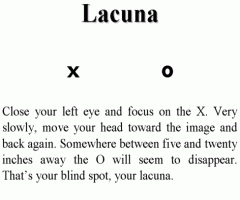
the spot where the optic nerve leaves the retina - has no rods or cones
|
|
|
optic nerve
|
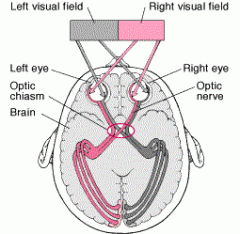
made up of axons of ganglion cells - impulses from the left side of the retina go to the left hemisphere and vice versa with right
|
|
|
optic chiasm
|
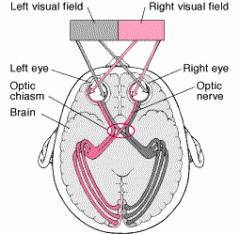
spot where nerves cross each other
|
|
|
feature detectors
|
activated by impulses from retinal cells, specialized neurons that respondto specific features of the visual stimulus. Detect vertical lines, curves, motion, and etc. Visual perception is a combination of all features.
|
|
|
David Hubel and Torsten Wiesel's Research
|
Specialized cells in the eye respond to specific visual stimuli.
Revealed the pattern of organization of brain cells that process vision, feature detectors |
|
|
trichromatic theory (Young-HelmholtzTheory of Color Vision)
|
theory hypothesizes that we have three types of cones that detect red, blue, and green that combine to form colors we see - does not explain after images and color blindness
|
|
|
opponent-process theory (Ewald Hering Theory of Color Vision)
|
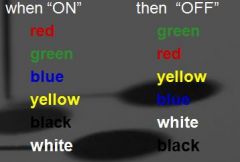
sensory receptors in the retina come in pairs - if one sensor is stimulated, its pair is inhibited from firing - explains afteriamges - fatigue after a while and pair will fire and you'll see afterimage
|
|
|
Characteristics of Sound waves Amplitude Frequency
|
Amplitude--height. determines loudness in decibels
Frequency--length, determines pitch (hertz) |
|
|
Process of Hearing
|
1. sound waves collected in the pinna (outer ear)
2. waves travel down auditory canal 3. reach the eardrum (tympanic membrane) 4. hammer, anvil, stirrup transmit the vibrations to the oval window 5. as the oval window vibrates, the fluid in the cochleamoves 6. hair cells on the basilar membrane (floor of cochlea) move, hair cells are connected to the organ of corti (neurons activated by movement of hair cells) 7. transduction occurs (organ of corti fires, auditory nerve sends these impulses to the brain) |
|
|
ear canal/auditory canal
|
canal sounds waves travel down
|
|
|
ear drum
|
tympanic membrane - thin membrane that vibrates as the sound waves hit it - head of a drum
|
|
|
hammer, anvil, stirrup (ossicles)
|
series of three small bones attached to the tympanic membrane
|
|
|
oval window
|
membrane attached to the cochlea
|
|
|
cochlea
|

structure shaped like a snail's shell - filled with fluid - as the oval window vibrates, the fluid moves
floor is lined with hair cells |
|
|
organ of corti
|
attached to the cochlea - neurons activated by movement of hair cells - when fluid moves, hair cells move and transduction occurs
|
|
|
place theory
|
hair cell sin the cochlea respond to different frequencies of sound based on where they are located in the cochlea.
Explains HIGH PITCH |
|
|
frequency theory
|
lower tones are sensed by the rate at which the cells fire. hair cells fire at different rates in the cochlea
Explains LOW PITCH |
|
|
Volley theory
|
Neural cells fire in volleys thatare correlated with the frequency of sound
Explains MID RANGE PITCH |
|
|
conduction deafness
|
something goes wrong with the system of conducting the sound to the cochlea (organs within ear, ear drum, HAS)
|
|
|
senorineural (nerve)deafness
|
hair cells in the cochlea are damaged by loud noise - prolonged exposure to noise that loud can permanently damage the hair cells of your cochlea
|
|
|
SkinSensations
|
cold , warmth, pressure, pain
|
|
|
pain receptors
|
nerve ending that responds to sharp simulation - useful in potentially dangerous situations
|
|
|
gate-control theory
|
some pain messages have higher priority than others, gate is open to it, and shut to lower priority messages
endorphins swing the gate shut |
|
|
4 taste (gustation) senses
(Chemical sense) |
sweet, salty, sour, and bitter
|
|
|
papillae
|
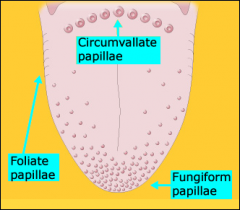
bumps you can see on the back of your tongue, contain taste buds
|
|
|
taste buds
|
located all over the tongue and some parts of the cheek and roof of mouth - the more densely packed together on the tongue, the more intense taste
|
|
|
Process of Smell (Olfaction, chemical sense)
|
1. molecules of substances rise into the air 2. molecules are drawn into the nose
3. they settle into a mucous membrane 4. absorbed by receptor cells 5. olfactory bulb gathers messages from the olfactory receptor cells 6. sends this information to the brain |
|
|
olfactory bulbs
|
are in olfactory system that receives olfactory receptor cells and sends them to the brain - nerve fibers from this connect to the brain at the amygdala and the hippocampus
|
|
|
limbic system
|
system that receives information from the olfactory system made up of the amygdala and the hippocampus responsible for emotional impulses and memory
|
|
|
why is smell such a powerful trigger for memories?
|
olfactory senses connect directly to the amygdala and the hippocampus which are responsible for emotional impulses and memory. All other sense impulses are sent through the thalamus before being sent to the appropriate cortices.
|
|
|
vestibular sense
|
tells us about how our body is oriented in space - controlled by three semicircular canals (partially filled with fluid) that give the brain feedback about body orientation
Ex. Maintaining balance |
|
|
kinesthetic sense
|
feedback about the position and orientation of specific body parts - receptors in our muscles and joints send information to our brain about our limbs
Ex. Need to know where body parts are when walking |
|
|
perception
|
process of understanding and interpreting sensations
|
|
|
psychophysics
|
study of the interaction between the sensations we receive and our experience of them
|
|
|
absolute threshold
|
the smallest amount of stimulus we can detect; the minimal amount of stimulus we can detect 50 percent of the time
Vision: Ex. Candle flame 30 mi. away Hearing: Watch ticking 20 ft. away |
|
|
subliminal
|
stimuli presentedbelow our absolute threshold
|
|
|
difference threshold/just-noticable difference
|
smallest amount of change needed in a stimulus before we detect a change
Ex. Add 1 ounce to 10-ounce weight, you will detect a difference. |
|
|
Weber's law
|
stated by Ernst Weber - change needed is proportional to the original intensity of the stimulus
Ex. if music was being playedsoftly, a small increase in sound would be noticeable… if music were beingplayed loudly, it would require a much greater increase in sound to perceive asdifferent |
|
|
signal detection theory
|
investigates the effects of the distractions and interference we experience while perceiving the world, tries to predict what we’ll perceive among competing stimuli. Takes into account how motivated we are to detect certain stimuli and what we expect to perceive
Ex. predictshow and when we detect the presence of a faint stimulus (signal) amidbackground stimulation (noise) |
|
|
false positive
|
a perceived stimulus that is not really there
|
|
|
false negative
|
not perceiving a stimulus that is present
|
|
|
top-down processing
|
perceive by filling in gaps in what we sense by using prior knowledge, experience, and expectations
Ex. Walk into room and see desk in rows, know it is test day |
|
|
schemata
|
mental representations of how we expect the world to be
|
|
|
perceptual set (expectancy)
|
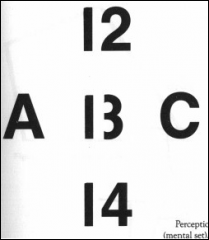
predisposition to perceive something in a certain way
|
|
|
backmasking
|
supposed hidden messages musicians recorded backward in their music in the 1980s
|
|
|
bottom-up processing (Feature Analysis)
|
only using features of the object to build a complete perception
Ex. recognizing a person by their voice Ex. putting together a puzzlewithout a picture. |
|
|
figure-ground relationship
|
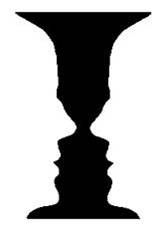
organizationof the visual field into objects (figures) that stand out from theirsurroundings (ground)
|
|
|
proximity (Gestalt principle of organization)
|
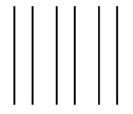
objects that are close together perceived as belonging in the same group
|
|
|
similarity (Gestalt principle of organization)
|

objects that are similar in appearance are perceived as belonging in the same group
|
|
|
continuity (Gestalt principle of organization)
|

objects that form a continuous form are grouped together
|
|
|
closure (Gestalt principle of organization)
|
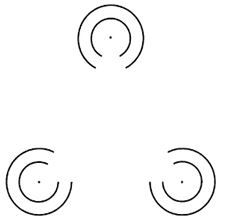
similar to top-down processing, objects that make up a recognizable image are more likely to be perceived as beloning in the same group even if the image contains gaps that the mind needs to fill in
|
|
|
constancy
|
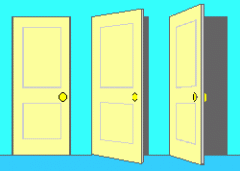
our ability to maintain a constant perception of an object despite the change in angle, variations in light and so on
Ex. Size constancy Ex. Shape constancy Ex. Brightness constancy |
|
|
phi phenomenon
|

series of light bulbs turned on and off at a particular rate appear to be one moving light
|
|
|
mononcular cues
|
depth cues that need only one eye
Ex. linear perspective (parallel lines converge with distance) Ex. relative size cue (larger objects appear closer) Ex. interposition cue (objects that block the view to other objects must be closer) Ex. Shadowing |
|
|
binocular cues
|
depth cues that need both eyes
Ex. binocular (retinal) disparity (closer the object, the more disparity there will be between the images from each eye) Ex. convergence (the more the eyes converge, the closer the object must be) |
|
|
Illusion
|
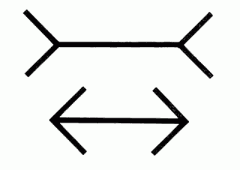
Incorrect perceptions. Occur when our brains cannot correctly interpretspace, size, and depth cues.
Ex. Muller-Lyer Illusion |

